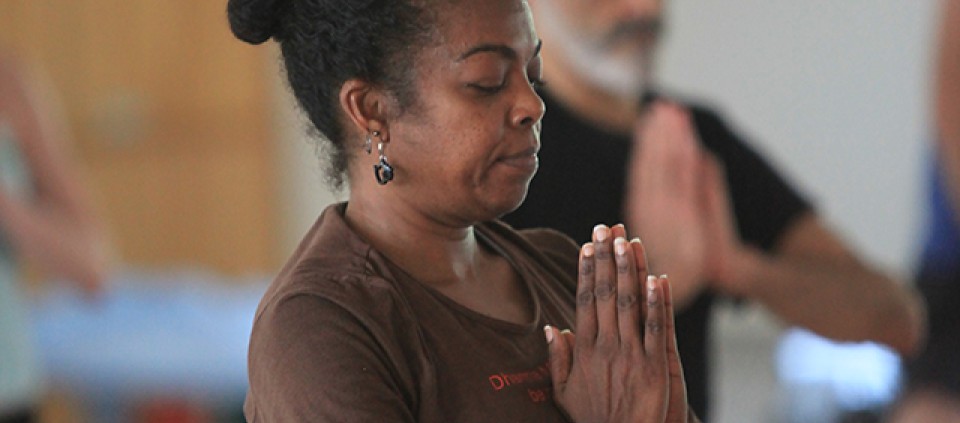Riding the Midlife Roller Coaster

by Janet Arnold-Grych
An article in Harvard Business Review explained that the weariness experienced by many of us in midlife is not unique, is not simply whining, and is not necessarily static. In fact, that downward sloping trajectory commonly shifts up as time goes on, forming a sort of “U.” That means that there is light—a lot of light—at the end of the U, if we can just keep moving.
The research relayed that this midlife phenomenon appears to be independent of economic status, gender, family status, and other variables. So it’s not just me. Commiserating, my friends and I have shared that we have many good things in our lives and yet still carry these murky feelings of dissatisfaction (which are then compounded by feeling guilty about being dissatisfied at all). But according to the research, and according to positive psychologist Maria Sirois, PsyD, these feelings are part of the journey.
Maria says, “It’s normal at some point in the middle of our lives to reevaluate work, relationships, etc. Health is often the driver of that reevaluation. Psychologists [Carl] Jung and [Erik] Erikson spoke about these shifts as well. What keeps us invigorated in our 50s is different than what did in our 20s, and we want to be open to these changes. These are all triggers for exploration.”
In our youth, we are filled with fire and expectation. In midlife, we begin to become aware of a balance sheet we’ve constructed that tallies effort and outcome, anticipation and realization. In many cases, we feel we’ve come up short somehow in what we’ve done or who we’ve become. Even if we stand in a very good place, things can somehow seem flawed. Add to that our increasing awareness of the ticking of time, and we might find ourselves wading in dis-ease, exhaustion, or befuddlement.
The goal isn’t to exit from this state as quickly as possible; rather, it’s to understand what it’s telling us. “You don’t want to deny what’s happening because, in some ways, it’s part of normal human development,” says Maria. “You might not even have language for this burgeoning transition and that’s okay. Explore it the way a young child might—get really interested in it.”
To gain insight, there are two major sets of tools available to help us—those that naturally arise as part of the maturing process and those we harness. Our brain chemistry appears to be on our side: Studies have shown that, as we age, we become better at dealing with ambiguity, applying social reasoning, and making decisions. So, rather than emphasizing comparison, competition, and a future focus, we’re more likely to see the value of connection, gratitude, and the present moment.
To capitalize on these changes and this time of life, a little purposeful digging toward the roots of our discomfort is warranted. Maria cautions, “Don’t expect insight to just materialize. You need to create the conditions to enable clearer vision. You want to get to the root of things and avoid black-and-white thinking. We might believe our restlessness is completely explained by ‘x’ when it’s really that we don’t have enough personal meaning or even enough joy in our lives. Allow yourself not to assign an answer, but to listen for one.”
Maria suggests a few strategies for tuning in to those whispers of insight.
Mindful Awareness
Especially if you can’t quite put your finger on what’s not working, allow yourself to step back and observe without judgment. Notice what comes up. Journaling can be a wonderful practice to give form to the inchoate voice. What am I really looking for? What am I unhappy about? What gives me joy?
Relationships that Nourish You
The people we love and trust can offer insights that we miss ourselves or are quick to dismiss. Engage them in open conversation, and allow yourself to fully take in the support they offer.
Mentorships
For generations, cultures around the world have looked to the experienced, to the wise, for guidance. These “non-credentialed experts” are people who have been through crossroads themselves and are able to offer insights. If your dissatisfaction seems tied to your job, for example, perhaps start looking for individuals who successfully left the company, or successfully reengaged, or successfully rebalanced. It’s not that we have to emulate their behavior exactly, but it can be tremendously helpful to hear their stories, and reassuring to know that there is light ahead.
Harvard Business Review labels midlife malaise a natural state; Maria terms it a wake-up moment. “Yes, it can be scary,” she says, “but it can also be tremendously exciting when we recognize that we do have options in terms of reshaping our lives.” You might naturally bob up from that midlife murkiness without paying it too much attention, but taking the time to thoughtfully explore both the downward slope and rising terrain will give you clarity as you move into the next exciting phase—whatever that might be.
Find out about programs with Maria Sirois at Kripalu.
Janet Arnold-Grych is a yoga teacher and writer whose work has been published in Elephant Journal, Huffington Post, Third Coast Digest, and other outlets.
© Kripalu Center for Yoga & Health. All rights reserved. To request permission to reprint, please e-mail editor@kripalu.org.